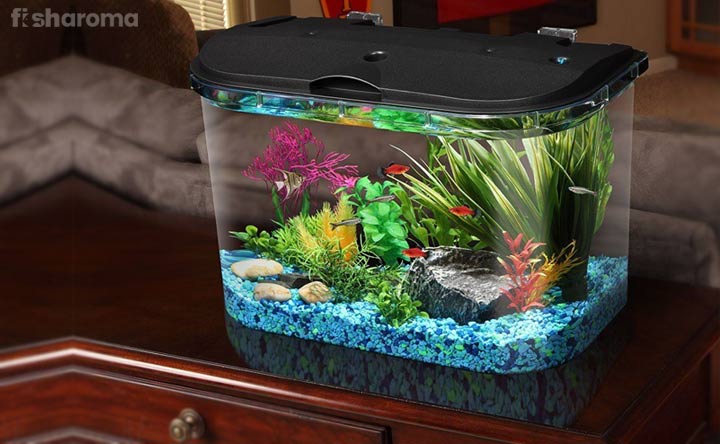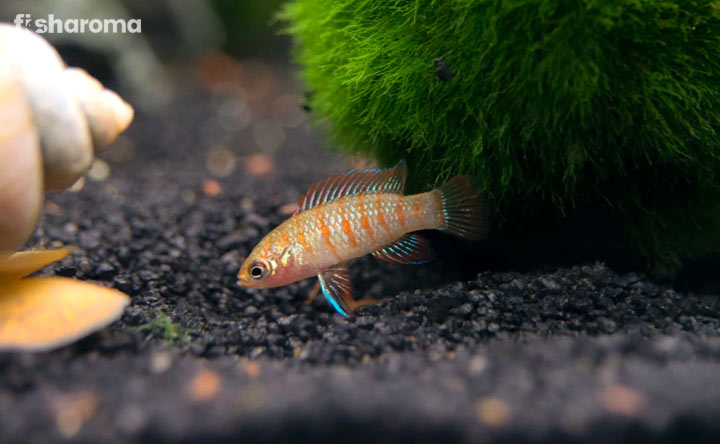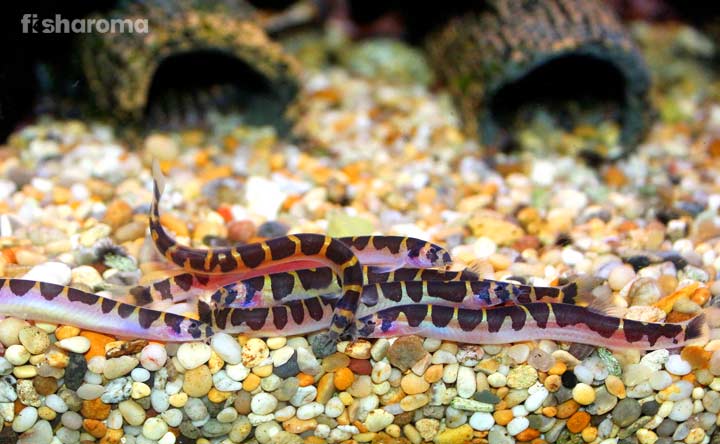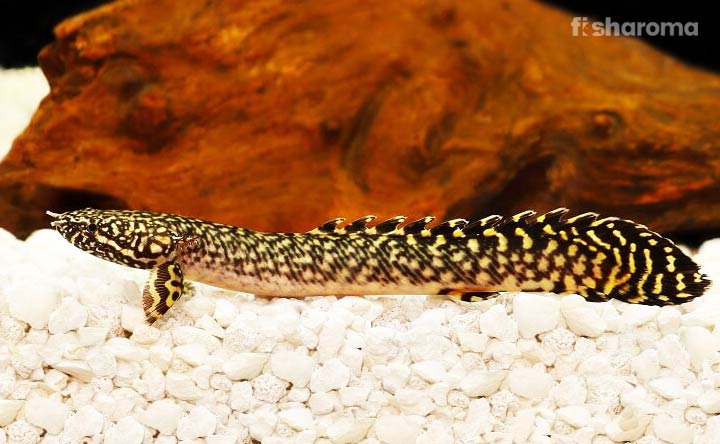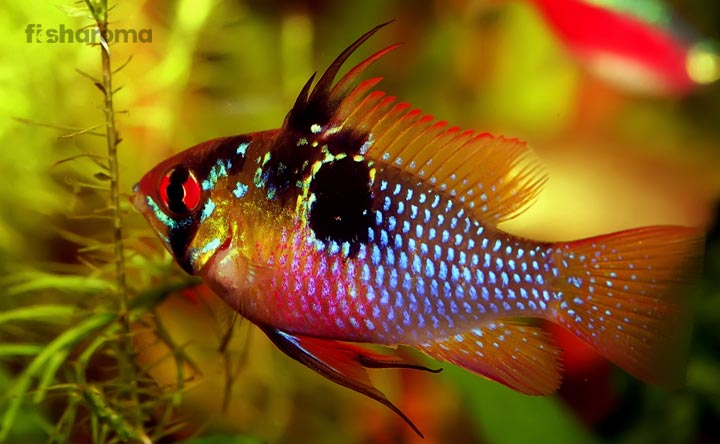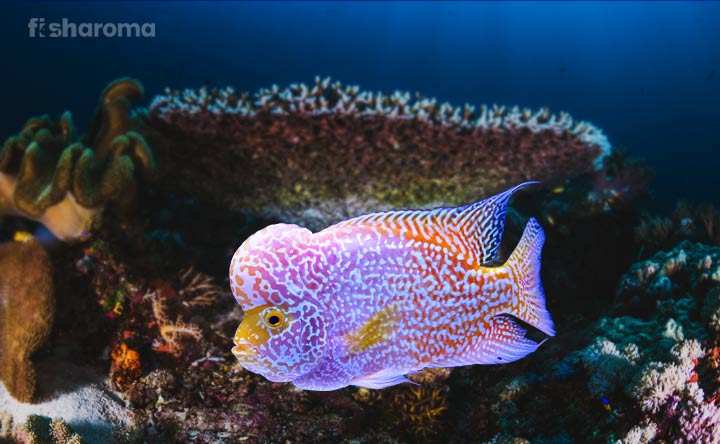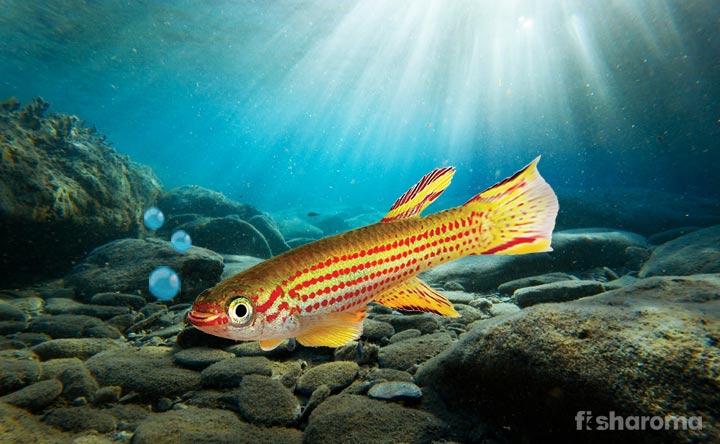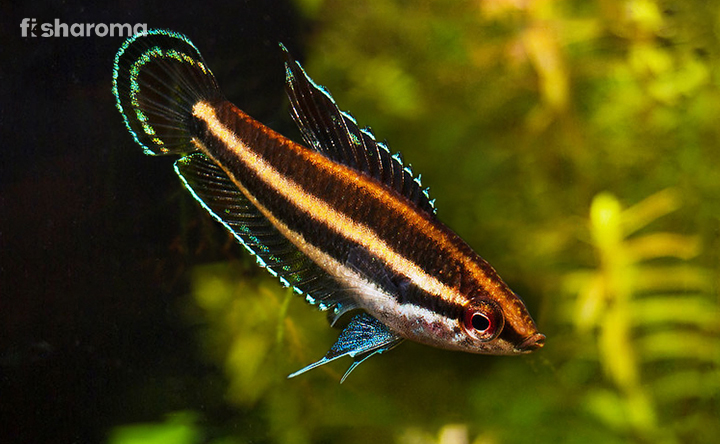Sparkling Gourami – The Complete Care Guide of This Magnificent Beauty
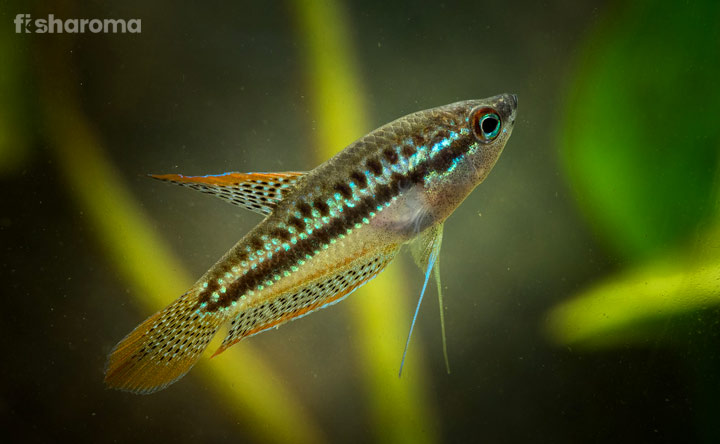
- Origin and Habitat of Sparkling Gourami
- Appearance of Sparkling Gourami
- Behavior of Sparkling Gourami
- Lifespan of Sparkling Gourami
- Diet of Sparkling Gourami
- Tank Requirements of Sparkling Gourami
- Water Type for Sparkling Gourami
- Compatibility of Sparkling Gourami
- Breeding of Sparkling Gourami
- Common Diseases of Sparkling Gourami
- Summary
Keeping an uncommon fish in your freshwater aquarium can help you to get pat on your back, especially when it has mesmerizing looks along with an ability to make sounds. Sparkling Gourami is such a species, and it comes with easy-care tips.
It is not that you need to be extremely skillful to pet such a rare fish – Sparkling Gourami allows beginners and minimum experienced aquarists to pet this shiny water gem. You don’t need to worry much about its maintenance, just take a look and learn how to care for this fish.
Key Specifications of Sparkling Gourami
We will go through the detailed, caring tips later but before that take a look at the key specifications of this fish here:
| Scientific Name | Trichopsis pumila |
| Family | Osphronemidae |
| Origin | Southeast Asia |
| Size | Up to 1.6” (4 cm) |
| Color | Brown body with multicolored dots |
| Care Level | Easy |
| Lifespan | 4-5 years |
| Temperament | Peaceful but males are aggressive |
| Compatibility | Low |
| Tank Size | 15 gallons |
| Diet | Omnivore |
Overview
Sparkling Gourami is also known as Pygmy Gourami, Dwarf Croaking Gourami, Purring Gourami, and Green Croaking Gourami. The term Pumila means dwarf or tiny. It is probably the smallest fish of the Gourami family. As it has the labyrinth organ, it is also blessed with an extraordinary ability to breathe directly from the air.
Origin and Habitat of Sparkling Gourami
It is a Southeast Asian fish, and it is widely available in slow-moving rivers, ditches, irrigation canals, lakes, swamp forests, streams, and rice fields of Southeast Asian countries like Indonesia, Cambodia, Laos, central and southern Thailand, Peninsular Malaysia, and Vietnam. This fish mostly lives in stagnant water and survives there quite well because of their labyrinth organ. It means that water with a low level of oxygen is not at all a problem for them.
Appearance of Sparkling Gourami
If you think that being an inhibitor of stagnant water, this fish will not have a stunning look, you will be wrong. This fish looks beautiful, but you may have to struggle to get this species as it is a rare one. It has an elongated body that is compressed on both sides and towards the ending. Its standing dorsal fin makes its appearance even better. The anal fin is seemed to merge with the caudal fins, and its pelvic fin is small and appears hairy due to the threadlike structure.
Eyes of this fish are quite large and blue with a rim of gorgeous red. It communicates by beating their pectoral fins alternatively, and you can hear these sounds. It’s not that hard to differentiate male and female fish – the longer fins of the males can easily make significant differences.
Size and Color of Sparkling Gourami
This fish is 1.6” (4 cm) when matured, and it has typically brown body with the scales having blue, green, and bluish-green dots. Its fins have a gradient of brown, which sometimes turn dark orange or red towards edges with the dotted texture.
It has to be mentioned that the pattern and texture of each fin are different, and you will see black and blue lines with numerous dots of blue-green and silver there. Due to this coloration, this fish sparkles like a jewel in clear water and color-changing lights.
Behavior of Sparkling Gourami
This fish is generally peaceful, but males can be aggressive in different times. Territorial fights are also very common for them. It prefers to swim all through the tank in a group of 4-6, though, it is a slow-swimmer. As they have an organ to breathe directly from the air, they are prone to swim to the surface level. Hiding in the caves is their favorite sport too.
Lifespan of Sparkling Gourami
Along with a good diet and accurate tank and water condition, Sparkling Gourami can live up to five years. Check the list of foods for this fish:
Diet of Sparkling Gourami
Being an inhabitant of stagnant water, you don’t need to put excessive effort to search for its food. This fish can eat anything it comes across. They happily consume flakes, pellets, live food, dry food, and frozen food.
Among the non-veg food, you can opt for Artemia, Daphnia, insects, Tubifex, Bloodworms, and Brine Shrimp. These foods help this fish to enhance the color and shine more. Algae-based flakes, along with these, will be mandatory.
In an aquarium, it has an appetite for the algae and other plant materials. But still, you need to feed them high-quality store-bought flakes to avoid health problems.
Experts Say…
Experts ask to feed this fish a diverse diet rich in protein, which keeps them energetic throughout the day. Also, it is advised to fix one or two times (try to feed it twice) of feeding this fish and understand the quantity of food from the experts.
It’s very important to be punctual in terms of feeding this fish. A little delay in feeding will make the fish quiet, shy, and stressed.
Tank Requirements of Sparkling Gourami
The health of Sparkling Gourami depends on how you have fulfilled its tank requirements. Know the ideal method to set up the best tank for this fish:
Tank Size
You will need a minimum 15-gallon tank for this fish. But if you want to keep it in a group of 4-6, a 30-gallon tank will be alright. More space will help this fish to be more active and would allow them enough space to swim.
Tank Lid
You will need the lid as this fish may jump out of the aquarium. But you will need to remove the lid for some time to allow them access to air as it needs air due to its natural ability to breathe from the air. Else, you can simply keep a distance of 10” (25 cm) from the water surface to the tank lid to facilitate their breathing.
Substrate
As per the opinions of the aquarists, this fish has a stunning appearance, and it looks majestic with dark substrates, which helps them to shine more. Not only the darker substrate will look good in contrast to their colors, but also it will reduce aquarium brightness. Walnut gravel can be used as a substrate.
Aquatic Plants
This fish likes thickly planted aquarium, but they never hurt the plants. They need floating plants to hide. Java Fern and Java Moss will be good for this purpose. Without these plants, the fish will get stressed.
It has a preference for vegetation, and you can make your aquarium shadowy with Tropical Lilies, Floating Salvia, Water Lettuce, and Cryptocoryne. You can grow multiple plants as this fish prefers slow-moving water.
Filter
Though they can survive in dirty water, fitting a filter will be better for their health. With a low-powered filter, you can control the flow of water. You need to remember that the water flow should not harm the shelters of this fish. With a canister filter, you will be able to replicate their preferred slow-moving water.
Lighting
9-10 hours of lighting is mandatory in the aquarium, and any dimmed lights will be alright for their comfortable lives.
Décor
If you have a very small aquarium, try not to put decors along with plants, which will make it difficult to look after the fish. In case you have a large aquarium, you can place decorations like logs driftwood and caves in such a way that the fish can move freely.
Place the decorations in different places rather than placing them in the middle so that your fish can get different places to explore and hide.
Water Type for Sparkling Gourami
Though it is a hardy fish, you will need to maintain the water quality to make sure its healthy lifestyle. In the natural habitat, although it can tolerate polluted water, its lifespan reduces because of it. In your aquarium, it’s your responsibility to keep maintain water parameters correctly to maximize its lifespan. Following tips can help:
Temperature, pH Level and Hardness
This fish can tolerate a wide range of temperature, like 71.5–82°F (21.9-27.7°C). However, 77°F (25°C) will be most comfortable for them. pH level should be 6.5 to 7.0, and water hardness should be 5-19dH. However, the fish can survive in the pH range of 5-8 as well.
Nitrate Level
Due to excess nitrate, the oxygen level will decay in the water, but Sparkling Gourami can survive in low oxygenated water. Still, you have to try to reduce the level of nitrate for better health of the fish. It is beyond doubt that nitrate is harmful to any fish, so reducing that will be better.
Cleaning Methods
Just like other aquariums, cleaning with chemicals or soaps is dangerous. But algae scrubbing and siphon cleaning will be alright.
Replacement Procedure
In case you have a small tank, 25% water change a week will be good. It that’s not possible, try 40% water change every 15 days. For larger than 25-gallon tank, you will need to change 10-15% water each week.
Even though this fish is not sensitive to water temperature and pH level, avoid tap water that has excessive chlorine. Using filtered water is preferred in areas where the tap water has an excess level of chlorine.
Compatibility of Sparkling Gourami
This fish has a schooling tendency, so it will be better to put 4-6 fish in an aquarium. But remember, males can be extremely aggressive and territorial. In case your aquarium is small, try to keep one male with 3-4 females since so that the male sparkling Gourami can have own territory.
Are you thinking about putting it in a community tank? Well, Sparkling Gourami will not disappoint you here. Check the next section.
Suitable Tank Mates of Sparkling Gourami
You will get several small and peaceful fish to keep with this fish. Sparkling Gourami does not mess with same-sized fish. Some best tank mates for this fish are:
- Corydoras Catfish
- Otocinclus Catfish
- Opaline
- Pearl Gourami
- Dwarf Gourami
- Licorice Gourami
- Rasboras
- Rainbowfish
- Kuhli Loach
- Rosy Loach
- Guppy
- Platy
- White Cloud
- Cherry Shrimp
Along with that, crustaceans like Ghost Shrimp and Nerite Snails can be good tank mates too. Some experts opine that keeping Sparkling Gourami in a community tank with small and peaceful fish is not a good idea as they will get the food last, and sometimes other fish will finish the food too. As a result, sparking Gourami will starve.
Unsuitable Tank Mates of Sparkling Gourami
Any aggressive fish and extremely slow-swimmers are to be avoided because Sparkling Gourami will either attack them or get attacked by them. Large fish will consider it as their food, cause stress and fear in this fish, so you have to avoid them.
Also, avoid fish with long tails and flowing fins as Sparkling Gourami may nip their fins. The list of unsuitable tank mates is quite large for this fish, some among them are:
- Bettas
- Black Tetras
- Cherry Barbs
- Tiger Barbs
- Any large Gourami
Breeding of Sparkling Gourami
It’s easy to breed this fish, and you will need to keep the ratio of males and females in 1:2 in the heavily planted breeding tank. Feeding high-protein food before breeding will be very good. As soon as you see the females with plump belly, you will need to prepare them for breeding.
Increasing the temperature (3-5 °F) can direct the fish to mate. Lowering the water level by 6” (15.24cm) will also be very helpful here. You can add the plants with large leaves like Anubias in the breeding tank. You must ensure that their tank is covered.
As these fish are bubble nest builders, males will build the nest under the plants and attract the females; and then wooing begins. Male fish swims around the female and embrace her when she lays the eggs.
Male fish then fertilizes the eggs and send them to the nest. Females lay eggs several times a day. After this is done, send the females back to your original tank. It is because males can be very aggressive to them.
Post-Hatching Care
Males will take care of the eggs until hatching. You will have to reduce the water flow so that the eggs cannot be carried away. Males also produce a gluey element to save the bubble nest.
Eggs will hatch after 2-3 days, and after the fries learn to swim away from the nests, you can separate the male parents. These small fries will eat plankton for a few initial days and after 2-3 weeks, feed them Infusoria And Nauplii.
You will need to change water frequently during the formation of their labyrinth organ (from the 2nd-4th week after hatching).
Common Diseases of Sparkling Gourami
Just like other aquatic species, you will need to be a really good observer as it is a tiny fish. Aquarists often skip the initial signs of sickness in this fish. Some common diseases in this fish are:
1. Ich or White Spot
Itch is the commonest disease in this fish, so keep checking for any abnormality (like rubbing body in substrates or lethargy) and nodules in its body. Ichthyophthirius multifiliis is the cause of this disease. Loss of appetite, cloudy eyes, and fast breathing are some other signs of this disease.
It may be a result of excessive polluted water or temperature mismatch, and you can cure the fish by adjusting these. The application of aquarium salt will be great too.
2. Fin Rot
Pathogens, like Pseudomonas fluorescens, transmit this disease. You can see red sore around the fin, and sometimes parts of the fin will fall. Weakness, loss of color, and appetite are the signs of fin rot.
You can apply antibiotics like tetracycline, amoxicillin, ciprofloxacin, or aquarium salt to cure this.
3. Costiasis
It is a protozoan disease where Ichtyobodo necatrix (protozoa) attaches itself to the body of the fish and causes dark patches along with respiratory problems. The fish will have a loss of appetite too. You can cure the fish with Praziquantel. Also, cleaning the aquarium and raising the temperature will work too.
4. Cotton Wool
This fungal disease is known as Columnaris, and it weakens the immune system of your fish. An infected fish has cottony growth throughout its body, and if it left untreated, ulcers would be formed. Aquarium salt can cure this.
5. Fish Fluke
Flukes are parasitic worms that get nutrition from the fish. The fish will become lethargic and have organ dysfunction along with ulcers and irritation. Potassium permanganate, Fluke tabs, Praziquantel, and Formalin, can be applied to cure this disease, and water change will be mandatory to drive this disease away from the tank.
- Due to the size of this fish, the application of any medicine or addition of aquarium salt is to be done after consulting experts.
- Maintaining water quality can save your sparkling fish from all these diseases.
- Just because it is hardy, you cannot neglect water change– that’s what you will need to remember.
Summary
Sparkling Gourami is one of the most lovable fish for aquarium. Many beautiful and colorful fish do not have this hardy nature – they are prone to a lot of diseases, and require excessive maintenance.
But Sparkling Gourami fulfills this gap. It not only has the least demands, but it accepts different food and copes up with a wide range of temperatures and pH levels. Also, you can definitely keep this fish if keeping Gourami is your dream, but your small aquarium had always been a hindrance.
So are you ready for everyone’s appreciation with this small dazzling beauty?
Interesting Facts about Sparkling Gourami
- You can hear this fish making chirping or croaking sound from the outside of the tank.
- Outside noise will scare this fish very easily.
- They love to hide under tree leaves, in aquarium corners and caves. Hiding is one of their favorite sports.
- This small fish holds near about a hundred eggs.
- Unlike most of the fish, Sparkling Gourami does not eat the fries.
- Females make a purring sound at the time of breeding.
- If you hear carefully, you will find differences between the sounds made by them in the presence of light and absence of light.
- You can differentiate males and females by illuminating lights on their bellies, which will clearly show you the ovaries of the females.
Some Other Gourami for Your Freshwater Aquarium
If Sparkling Gourami interested you, the following Gouramis will probably appeal to you as well:
- 17 Beautiful Gourami Fish – Get the list of most popular Gouramis and know how to care for them.
- Honey Gourami – Honey Gourami is a beautiful yellow Gourami that will beautify your aquarium. Know everything about its requirements.
- Paradise Gourami – It is a shiny Gourami that will mesmerize you with its looks and nature. You can go through its care guide.

